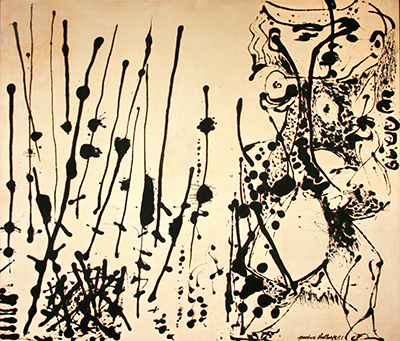In 1945, the American artist, Jackson Pollock (January 28, 1912 – August 11, 1956), married his fellow artist Lee Krasner. Between 1947 and 1950, Pollock painted Number 7.
As a major figure in the abstract expressionist movement, Pollock was reported to have said that his art was representational some of the time, and a little representational all of the time. Number 7 is a good example of the expressionist movement that was popular at the time.
In Pollock’s paintings in the early 1940’s, the intricately tangled layers of poured paint obscured and disguised figures. Pollock said that when he painted out of his unconscious, figures were bound to emerge.
This is perhaps best demonstrated in Number 7, (1952), where the knotted strands of dripped oil, enamel, and aluminum paint combine to form a obvious portrait head in a right three-quarter profile on canvas.
Using black paint, that are varied in width, length and density, this calligraphic form is reminiscent of a doodle on a post-it note. Art critics argue that Number 7 marks the moment Pollock had his ‘Eureka!’ moment: He realized that he could maintain the excitement of his classic style but use mono black on canvas.
His use of the abstract long black lines, with perpendicular flicks, marks and ink splurges create the impression of reeds blowing in the breeze. The variety and constant uncertainty of line widths and lengths suggest a mind racing with thoughts.
With black lines arranged in diagonal and irregular pattern at the bottom of the image, Pollock is exploring shapes and textures using the paint.
The black ink appears to drip and run, forming irregular shapes and textures. It could be argued that Number 7 is an artistic interpretation of his state of mind: he was a reclusive alcoholic during this period of his life and the use of black may reflect his mood.




